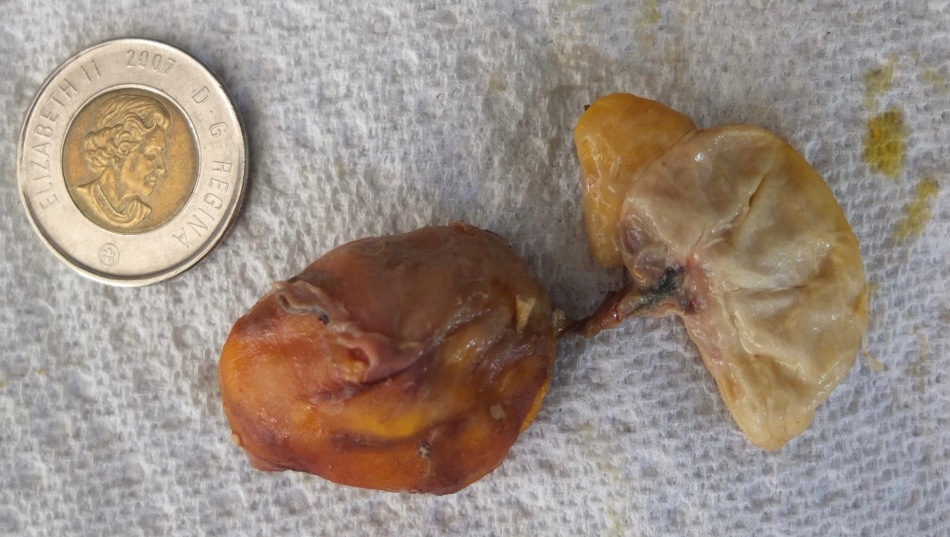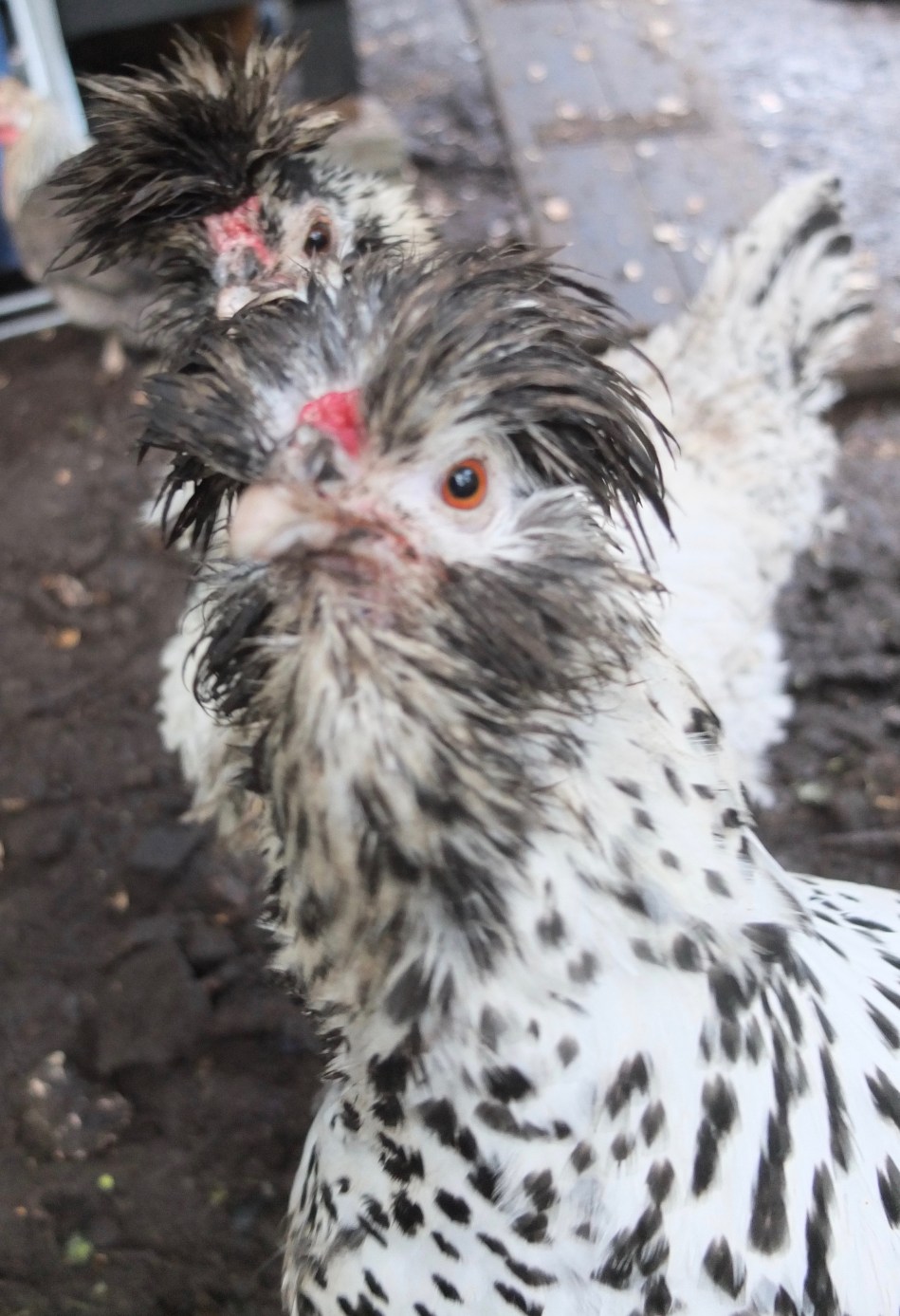Folks who work in high-pressure jobs that deal with the darker side of life – cops, paramedics, emergency room personnel – are often known for their dark senses of humour. In their case, it’s not about disrespect, but a way of managing difficult situations. Levity breaks the tension and allows you to keep moving forward without cracking up.
If my title seems a bit inappropriate, it’s a reflection of a tough month coping with recurring health emergencies with one of my favourite hens. She, and her half-sister and hatchmate, Skye, have been two of my friendliest and most striking birds so it’s been difficult figuring out what was going on and weighing what was the best course of action.
I have written two other pieces involving Corazon, my 10 month old Appenzeller Spitzhauben x hen. The first involved a minor prolapse after passing a soft-shelled egg, which was following by a series of major prolapses which I attempted, unsuccessfully, to manage.

I made the difficult decision to have her euthanized by my friend Thomas, who gave me back some interesting ‘pieces’ he found during the necropsy. I immediately recognized the classic signs of a salpingitis infection, commonly referred to as ‘lash egg’. I was curious to know more.
I sent Corazon’s case history and the necropsy photos to Dr Vicki Bowes, Avian Pathologist, at the Animal Health Centre in Abbotsford, B.C. I was interested in her opinion and wanted an explanation for what happened. Had I known she had an infection I would have sent Corazon’s body to the Lab for a complete analysis. It’s worth getting a professional necropsy for a full and accurate picture of issues affecting your flock.
I included the following information and questions:
- At the top of her reproductive system was the start of an egg, no shell and when cut it was full of yolk. How long would that have been there?
- Mid-way down there were two salpingitis masses.

- Close to her vent were a number of growths. What are they?

- Is this is a chicken & egg situation? Did the prolapses contribute to the salpingitis infection or the other way round?
- How long would she have been infected to accumulate that large egg-sized mass?
- At no point did she appear sick – no classic penguin stance or waddle. She was perky through it all.
- I never found any remnants of a ‘lash egg’ (salpingitis) before her death.
Her response:
Thanks for sharing your juicy pictures (you have to love a woman who thinks necropsy photos are interesting). What I see definitely started their life as ova (yolk) but couldn’t complete the process of forming the egg to be laid. The laminated layers are fibrin (inflammatory exudate). My best guess is that they could have been there 7-10 days, possible longer but the process has been ongoing.
Based on the history of chronic prolapse you can write the story either way, but since salpingitis is extremely common and it is RARELY associated with prolapse I favour the theory that the prolapse generated physical obstruction which is why the eggs backed up, unable to pass despite straining. Only a culture would reveal if there were any bacteria involved, as we see in bacterial salpingitis without prolapse.
Initial prolapses are easy to push back in, but without a ligation (i.e purse string suture) to set it back in place and keep it there, chronic prolapses are inevitable. The exposure of that delicate mucous membrane to the air then leads to swelling, inflammation, scarring & cannibalism and that is what causes the physical obstruction to egg laying. If she stayed in lay then internal lay would be a secondary consequence. The fact she was “perky” suggests a lack of bacterial infection, or at least a very localized one.
Common causes of prolapse are: excessive abdominal fat, excessively large eggs or small pelvic frame for the size of eggs, infection of the vent (bacteria or fungus (look up “vent gleet”), local tumours (this could be your answer since the bursa can develop tumours with Marek’s Disease and Leucosis).
Not much to change going forward but keep your eye on the other girls for similar issues.
My take-away:
- She was a slight hen with a small pelvic frame, a new layer with a history of soft-shelled eggs (even though I fed her high calcium foods) who probably prolapsed due to straining to lay. She didn’t have vent gleet and my flock, as far as I know, has not had cases of Marek’s Disease or Avian Leucosis.
- In future, I would attempt to deal with a minor prolapse, or even a major one, only once regardless of how successful I was in pushing the prolapse back inside.
- If there was evidence that the prolapse was outside the body for a sustained time (hers wasn’t) or damage to the tissue by other hens pecking it (her was) I would think of euthanasia much sooner. What I didn’t realize is how long the damaged tissue would take to heal and the pecking injury was probably the site of the infection.
- Given that it is common for a prolapse to recur, I would be quicker to euthanize a hen if there was a subsequent prolapse. Corazon was crated for the better part of a month in an attempt to inhibit laying and to allow the internal tissues to heal. She didn’t appear ill so I felt terrible keeping her confined. I vacillated between wondering if all my efforts were helping her or if I was prolonging the inevitable. In hindsight, I feel I should have made the difficult decision to euthanize her sooner.
I’m hoping if you ever have to deal with a prolapsed vent you can learn from my experience and save yourself some heartache and your hen some undue suffering. Consider sending a culled bird (or one who dies unexpectedly) for a necropsy to see what their analysis reveals. I’m most appreciative of the information I received.



Thank you; very informative. Sorry for your loss.
LikeLiked by 1 person
It seems these days, I am finding so many issues which, by way of your articles, I have a better understanding of my situation. I currently have a hen who walks like a penguin, follows me everywhere and does not appear to be in pain. Three weeks ago, I gave her the full spa treatment and checked to see if an egg were stuck inside her. I massaged her tummy and legs and found nothing, however she has somewhat of a red tummy, but not horribly so. She loved the spa attention and stood still in her penguin stance as I blow dried her. Since then, she has decided I was her friend and continues to greet me and follow me around the pen and coop. She has taken a liking to 90 3 month old chicks I have raised and introduced to the flock this week. I am very curious about her condition and concerned about knowing when it is time to euthanize her.
LikeLiked by 1 person
I’m actually here reading this because today, my young golden sexlink that’s been laying normally for about 3 months was acting strange today. She was standing puffed up and liquid coming out of her vent. It looked like water and then all the sudden a soft egg hit the ground. I was thinking it was over and she would be better but she remained puffy and acting like there may be another egg that needed to come out so I put some olive oil in a syringe and put some at the entrance of her vent and she pooped A LOT after that. This was late in the day today and she did eat some of her laying crumbles and also did see her eat some oyster shell. I’m worried about her tonight and hoping it’s resolved when I go out in the morning. Any thoughts of why the soft egg after all 7 hens have been laying fine for months? She hadn’t laid an egg in about 3 days so I’m thinking she may have another stuck inside even after laying the one soft one today.
LikeLiked by 1 person
Are your hens on Layer pellets or All Flock/Grower with access to crushed oyster shells? The soft-shelled egg might be a one off and isn’t necessarily a sign of future issues. To find out if there is an egg that is stuck inside you can glove your hand, lube your index finger and insert it into her vent. If you can feel an egg within the first 2″ that may be a sign of a problem if she doesn’t lay it soon. Does she have any other symptoms? How is she doing today?
LikeLike
Thanks for the response! She did lay another egg when I checked this morning and it was normal, thank goodness! She is acting fine now. I have had them on Purina organic layer crumbles since they started laying and yes, they have oyster shell and grit at all times. I guess it was a fluke, I guess I’ll never know. I just hope it doesn’t happen again. I worried all night and wanted to go check but I didn’t want to disturb them all. My neighbor says it’s because I feed them the layer crumbles and not the pellets but that seems ridiculous because they both have the exact same ingredients. Just because something is smashed up, doesn’t make it a completely different product. Correct me if I’m wrong but it doesn’t make sense to me. I went to buy feed today and they were out of the crumbles so I had to buy the pellets. I hope they eat it and are able to eat it because I have a tiny chicken that is the size of a dove and idk if she can eat pellets.
LikeLiked by 1 person
My entire flock is on Grower Crumbles because I have a rooster who doesn’t need and can’t utilize the additional calcium in Layer feed. They also have a dish of oyster shell available. There’s no difference in digesting crumbles vs pellets. Let’s hope it was a one off with your hen.
LikeLike